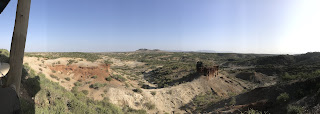Ngorongoro Crater and Olduvai Gorge
We have come to Tanzania to see the Ngorongoro crater, and arrived last night. The crater itself is a caldera — a volcano that blew it self up and then collapsed on itself. Like Crater Lake in Oregon, or the volcano we saw on Easter Island. But this crater is huge.
There is a lake inside the crater (probably more than one) and although you cannot see it from up on the rim, the crater floor is teeming with wildlife.
But before we get to that, last night we had a talk by Louise Leakey about the work of her grandfather and then her father and mother in excavating fossils from nearby Olduvai Gorge. And then she stayed over at the lodge and this morning led a group to Olduvai Gorge.
We went with her. She is a fascinating person who knows an enormous amount about fossils and such. She explained the various layers in the Gorge which are separated by layers of volcanic ash — which is very important. You cannot date the fossils themselves. But the layers of ash have properties that allow them to be dated. So you can date a layer of fossils as being between the layer of ash below and the layer of ash above. Which is why a bone, or a skull, by itself is not helpful; you need to put it in the context of where it was found, in order to be able to date it.
We went down into the gorge to the actual site where one of the famous early humanoid skulls was found. She gets out of the car and just walking into the excavation site, can bend down and pick up what appears to me to be rock debris and then say “this is a fossil, part of a tooth”, but not of any significance. She was fascinating.
Then we drove back up to the crater rim, and down into the crater. This switches from focusing on the bones of the distant past to the living wildlife of today.
Like giraffes.
And zebras. And buffalos. Wildebeest. Antelope. Hippos (in the lake). An elephant or two. A lion. Warthogs. Lots of animals. Linda took lots of pictures of them. So we can say we went to Africa and shot lions and elephants and zebras and giraffes (oh my!).






Comments
Post a Comment